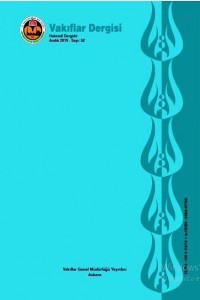Abstract
Camilerin
gelişimi açısından Osmanlı klasik mimarisinin zirvesi olarak kabul edilen
Selimiye Camisi ve bağlı yapıları, Edirne’deki yüksek bir tepe üzerine
yerleştirilmiştir. Yapı olarak zaten anıtsal olan caminin yüksek bir yere
yerleştirilmesi, etkileyiciliğini artırmakta, imparatorluğun ihtişamlı gücünü
göstermektedir. Bu bakımdan makalemizde Edirne kentinin öne çıkan tarihi
yapılarına kısaca değinilmiş, Selimiye Külliyesi’nin araziye yerleştiriliş
durumu gözler önüne serilmeye çalışılmıştır. Selimiye Külliyesi’nin
yerleştirildiği alanın XVI. yüzyıl öncesine kadar nasıl değerlendirildiği
konusu irdelenmiş ve sonrasında inşâ edilen Külliye ve etrafının topografik
analizi yapılarak, Mimar Sinan’ın alanı kullanma özelliklerine değinilerek,
makale sonuca bağlanmıştır.
Keywords
References
- Ahmet Refik (1931). Mimar Sinan, İstanbul: Kanaat Kütüphanesi.Arif, B. (1931). “Edirnenin İmarı”, Mimar, S. 10, İstanbul, s. 317-318.Ayverdi, E. H. (1972). Osmanlı Mimarisinde Çelebi ve II. Sultan Murad Devri 806-855 (1403-1451) II, İstanbul.Ayverdi, E.H., Yüksel, İ. A. (1976). İlk 250 Senenin Osmanlı Mimarisi, İstanbul: Fetih Cemiyeti Yayını.
- Bozdoğan, M., Ovalı, P. K., Özkan, S. (2006). “Mimar Sinan’ın “Koruma” Anlayışı ve Günümüzde Sinan’ın Eserlerini “Koruma” Anlayışı (Edirne Örneği)”, Trakya Üniversitesi, J. Sci, 7 (2), s.143-152.Cansever, T. (2005). Mimar Sinan, İstanbul: Albarakatürk Yayınları,1.Baskı.Cezar, M. (1985). Tipik Yapılariyle Osmanlı Şehirciliğinde Çarşı ve Klasik Dönem İmar Sistemi, İstanbul: MSÜ Yayını.Dukas (2013). Dukas Kroniği 1341-1462, Çev. V. Mirmiroğlu, İstanbul: Kabalcı Yayınevi. Edirne (2013). Edirne, Kendini Koruyan Kentler, İstanbul: Çekül Vakfı Yayınları.
- Eyice, S. (1965). “Bizans Devrinde Edirne ve Bu Devre Ait Eserler”, Edirne’nin 600. Fethi Yıldönümü Armağan Kitabı, Ankara: T.T.K. Yayını, s.39-76.
- Kazancıgil, R. (1994). Edirne Rehnüması, Edirne: Türk Kütüphaneciler Derneği Edirne Şubesi Yayını.
- Kuban, D. (1994). “Sinan (Mimar)” Maddesi, İstanbul Ansiklopedisi, C.6,s.563.
- Kuban, D. ( 2007). Osmanlı Mimarisi, İstanbul: Yem Yayınları.
- Kansu, Ş. (1965). “Edirne’nin Tarihöncesine Ait Araştırmalar”, Edirne’nin 600. Fethi Yıldönümü Armağan Kitabı, Ankara: T.T.K. Yayını, s.13-19.
- Kuran, A. (1964). “Edirne’de Yıldırım Camii”, Belleten, XXVIII/3, Ankara: T.T.K. Basımevi, s. 419-438.Kuran, A. (1986). Mimar Sinan, İstanbul: Hürriyet Vakfı Yayınları,1.Baskı.Mansel, A. M. (1965). “İlkçağ’da Edirne”, Edirne’nin 600. Fethi Yıldönümü Armağan Kitabı, Ankara: T.T.K. Yayını, s.21-37.
- Mustafa Sai Çelebi (2002). Yapılar Kitabı, İstanbul: Koçbank Yayını.Özdeş, G. (1951). Edirne İmar Planına Hazırlık Etüdü, İstanbul: İ.T.Ü. Mimarlık Fakültesi.Peremeci, O. N. (1939). Edirne Tarihi, İstanbul: Resimli Ay Matbaası.
- Sav, M. (2011). “Süleymaniye Camii Çevresinin Arkeotopografyası ve Mimar Sinan’ın Alan Seçimi”, Vakıf Restorasyon Yıllığı (VRY), S.3, s.62-79.
- Yücel, E. (1975). “Tarihi Görünümünden Uzaklaşan Edirne”, Arkitekt, S. 358, s. 70-71.
Abstract
The
Selimiye Mosque and related buildings of the mosque complex had all been constructed
on the highest hill of Edirne. The location of the mosque increases its attraction
and emphasizes the glorious power of the Empire while the architecture of
mosque itself already has a monumental impression. In this context, the study mentions
briefly about the well-known historical buildings of the city and elaborates on
the way Selimiye Complex located. The usage of the land till 16th century on
which the Selimiye Complex had been constructed has been investigated,
topographical analysis of the Complex and surrounded environment is performed and
additionally the way Architect Sinan preferred to handle the land has been
touched upon.
References
- Ahmet Refik (1931). Mimar Sinan, İstanbul: Kanaat Kütüphanesi.Arif, B. (1931). “Edirnenin İmarı”, Mimar, S. 10, İstanbul, s. 317-318.Ayverdi, E. H. (1972). Osmanlı Mimarisinde Çelebi ve II. Sultan Murad Devri 806-855 (1403-1451) II, İstanbul.Ayverdi, E.H., Yüksel, İ. A. (1976). İlk 250 Senenin Osmanlı Mimarisi, İstanbul: Fetih Cemiyeti Yayını.
- Bozdoğan, M., Ovalı, P. K., Özkan, S. (2006). “Mimar Sinan’ın “Koruma” Anlayışı ve Günümüzde Sinan’ın Eserlerini “Koruma” Anlayışı (Edirne Örneği)”, Trakya Üniversitesi, J. Sci, 7 (2), s.143-152.Cansever, T. (2005). Mimar Sinan, İstanbul: Albarakatürk Yayınları,1.Baskı.Cezar, M. (1985). Tipik Yapılariyle Osmanlı Şehirciliğinde Çarşı ve Klasik Dönem İmar Sistemi, İstanbul: MSÜ Yayını.Dukas (2013). Dukas Kroniği 1341-1462, Çev. V. Mirmiroğlu, İstanbul: Kabalcı Yayınevi. Edirne (2013). Edirne, Kendini Koruyan Kentler, İstanbul: Çekül Vakfı Yayınları.
- Eyice, S. (1965). “Bizans Devrinde Edirne ve Bu Devre Ait Eserler”, Edirne’nin 600. Fethi Yıldönümü Armağan Kitabı, Ankara: T.T.K. Yayını, s.39-76.
- Kazancıgil, R. (1994). Edirne Rehnüması, Edirne: Türk Kütüphaneciler Derneği Edirne Şubesi Yayını.
- Kuban, D. (1994). “Sinan (Mimar)” Maddesi, İstanbul Ansiklopedisi, C.6,s.563.
- Kuban, D. ( 2007). Osmanlı Mimarisi, İstanbul: Yem Yayınları.
- Kansu, Ş. (1965). “Edirne’nin Tarihöncesine Ait Araştırmalar”, Edirne’nin 600. Fethi Yıldönümü Armağan Kitabı, Ankara: T.T.K. Yayını, s.13-19.
- Kuran, A. (1964). “Edirne’de Yıldırım Camii”, Belleten, XXVIII/3, Ankara: T.T.K. Basımevi, s. 419-438.Kuran, A. (1986). Mimar Sinan, İstanbul: Hürriyet Vakfı Yayınları,1.Baskı.Mansel, A. M. (1965). “İlkçağ’da Edirne”, Edirne’nin 600. Fethi Yıldönümü Armağan Kitabı, Ankara: T.T.K. Yayını, s.21-37.
- Mustafa Sai Çelebi (2002). Yapılar Kitabı, İstanbul: Koçbank Yayını.Özdeş, G. (1951). Edirne İmar Planına Hazırlık Etüdü, İstanbul: İ.T.Ü. Mimarlık Fakültesi.Peremeci, O. N. (1939). Edirne Tarihi, İstanbul: Resimli Ay Matbaası.
- Sav, M. (2011). “Süleymaniye Camii Çevresinin Arkeotopografyası ve Mimar Sinan’ın Alan Seçimi”, Vakıf Restorasyon Yıllığı (VRY), S.3, s.62-79.
- Yücel, E. (1975). “Tarihi Görünümünden Uzaklaşan Edirne”, Arkitekt, S. 358, s. 70-71.
Details
| Primary Language | Turkish |
|---|---|
| Journal Section | Articles |
| Authors | |
| Publication Date | December 31, 2019 |
| Submission Date | May 27, 2019 |
| Acceptance Date | October 25, 2019 |
| Published in Issue | Year 2019 Issue: 52 |
The articles sent to the Journal of Waqfs with a request for publication are subject to preliminary examination by the Editorial Board and at least two academicians who are experts in their fields are sent for review. The copyright of the articles accepted to be published in the Journal of Waqfs with the referee reports and the decision of the Editorial Board is deemed to have been transferred to the General Directorate of Foundations, and a royalty fee is paid to the published articles in accordance with the relevant legislation.


